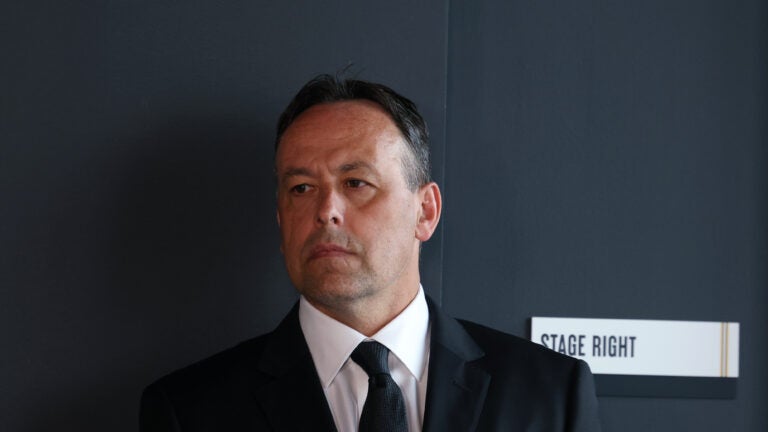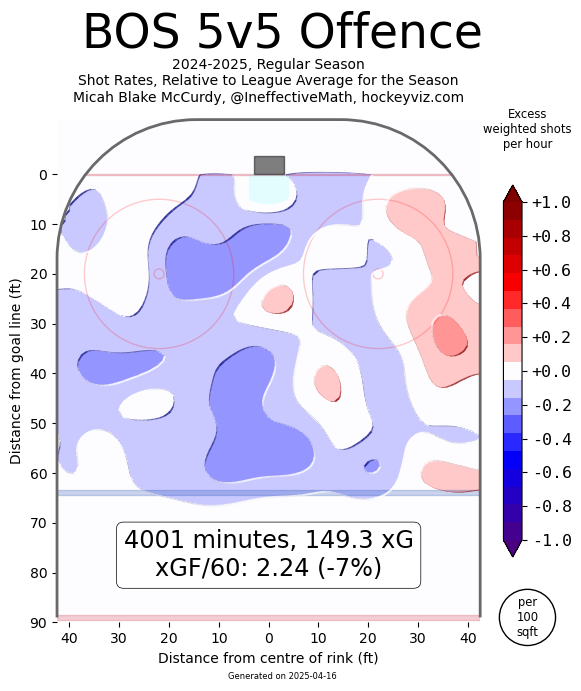
Bruins
“I think in the Bruins DNA is playing well defensively, that’s not going to change, but we have to find a way to be more productive offensively.”

If “alignment” was the buzzword during Craig Breslow and Sam Kennedy’s Zoom address following the Rafael Devers’ trade, “evolve offensively” might as well be the mantra for the 2025-26 Bruins.
Not only did Don Sweeney relay that message during Boston’s end-of-season presser in April, but it was mentioned on multiple occasions during Marco Sturm’s June 10 introductory press conference.
Sturm has his work cut out for him when it comes to righting the ship in Boston, with the first-time bench boss tasked with shoring up Boston’s defensive structure, spurring the development of younger players, and selling his vision to veterans like David Pastrnak and Charlie McAvoy.
But if the Bruins want to really take a step forward and address the glaring deficiencies in their roster, it’s evident that they need to unlock more offense out of this roster.
“I think in the Bruins DNA is playing well defensively, that’s not going to change, but we have to find a way to be more productive offensively,” Sturm said. “That’s going to be our goal and what we’re going to address from Day 1, and obviously special teams will be a big part, too.”
Beyond David Pastrnak’s expected offensive dominance (43 goals, 106 points) and a breakout season from Morgan Geekie (33 goals), Boston’s offense labored throughout the 2024-25 campaign.
The baseline stats were ugly — with Boston ranking 27th in the league in goals per game (2.71) and 29th in power play success rate (15.2 percent)
The underlying numbers were just as unsightly.
During even-strength play, the Bruins ranked 31st in the league in shot attempts (3,859), 29th in shots on goal (1,769), and 31st in high-danger scoring chances (684).
The Bruins have the cap space and potential draft capital to add some firepower via free agency or trade this offseason.
But the Bruins also can’t simply throw a boatload of cash on the free-agent market in hopes of solving their scoring woes.
If the Bruins want to take a step forward on offense, Sturm is going to have to change up the team’s overall O-zone approach in order to unearth more scoring punch out of the current personnel in place.
The best path for now revolves around embracing chaos in the offensive zone.
Peppering the net
During Jim Montgomery’s tenure in Boston, the Bruins adopted a “quality over quantity” approach when it came to their shot selection.
Rather than flinging every puck on net in the offensive zone (raising the risk of giving up possession as a result), the Bruins opted to boost their odds of generating Grade-A chances by being more selective with their shots — prioritizing attempts from the slot and other high-danger looks.
That approach did lead to an uptick in Boston’s 5-on-5 offense during Montgomery’s first two seasons. It’s a winning strategy … so long as you have the proper talent in place to be that judicious with shots.
Of course, when the Bruins’ offense spiked in 2022-23 — they also had Patrice Bergeron and David Krejci driving play in the top six, along with players like Tyler Bertuzzi, Taylor Hall, and Charlie Coyle sprinkled across the second and third lines.
The 2024-25 Bruins did not boast that same scoring depth and finishing ability across their roster. And barring a miraculous sequence of offseason maneuvering from Sweeney, the Bruins aren’t going to be adding 3-4 new forwards this summer — all with 20+ goal potential.
As such, the Bruins should rip up their shot-selection approach in 2025-26 and opt for the approach instilled during the Bruce Cassidy era — which involves peppering the net from all angles on the ice.
Firing volley after volley of vulcanized rubber on net could lead to an uptick in low-danger attempts that could sacrifice puck possession.
But that approach should also boost Boston’s odds of generating the tips, rebounds, and other greasy scoring chances that can help a team light the lamp at a higher clip when they don’t have the personnel in place to consistently cash in on rush chances or attempts from the slot.
It’s a strategy that has been utilized by the Carolina Hurricanes for years under Rod Brind’Amour.
Since the 2022-23 season, the Hurricanes have ranked first in the NHL in shot attempts at even-strength play each of the last three years — with a Carolina roster short on elite talent routinely creating offense by putting pucks on net.
The Panthers boast a lot more scoring firepower, but they’ve also benefited from that same shot-ready approach over the last few seasons — ranking second behind Carolina this past season in shot attempts at even-strength play.
During Boston’s last postseason series against Florida during the 2024 Stanley Cup Playoffs, the Panthers out-attempted Boston at even-strength action, 330-231.
The Bruins have a lot of work to do when it comes to building a roster as deep as Florida’s. But given how hard Boston had to work for offense in 2024-25, letting pucks fly early and often can only help their case.
Getting the D corps involved
A big part of Carolina and Florida’s success also has to do with preaching a shot-first approach from the blue line — with those attempts from the point or high slot also boosting the chances of a tumbling biscuit creating a juicy rebound down low.
Of the 256 NHL defensemen who logged at least 200 minutes of even-strength ice time this past season, Carolina had seven (!) different blueliners in the top 50 when it came to shot attempts per 60 minutes of play.
Brent Burns was second in that sizable pool of skaters at 17.78 shot attempts per 60 minutes, with even a stay-at-home stalwart like Jaccob Slavin ranking 44th at 12.66 shot attempts per 60.
Florida had two defensemen in the top 50 grouping, led by Gustav Forsling at No. 15 overall (15.36).
The Bruins’ top defenseman last season when it came to attempting shots was Hampus Lindholm (27th overall, 14.03), and he was lost for most of the season with a knee injury.
The next best Bruins D-man in that category was Nikita Zadorov at No. 111 overall, while other regulars like Mason Lohrei (9.68 shot attempts per 60, No. 137 overall) and Charlie McAvoy (9.15 shot attempts, No. 164 overall) also left a lot to be desired.

It might take some repeated preachings to coax more of a shot-first approach from skaters like McAvoy.
But an uptick in those point shots can carve out an easy avenue for the Bruins to generate quality looks when they don’t have the skill to routinely capitalize on the rush or other Grade-A opportunities.
The Bruins need to simplify moving forward. Get bodies to the net and let the shots fly.
Prioritize pressure and pace
We won’t get a full look at Sturm’s vision for Boston’s offensive structure until we get to training camp.
But speaking during his press conference, Sturm preached puck play, execution, and pace as the foundation of what he’s looking to gain in the O-zone.
“When I talk about scoring more goals, scoring goals is not just (playing) in the offensive zone,” Sturm said. “Yes, that’s where the puck is going to end up, but for me it always starts with: How are we going to get there? That’s a big part, too, not just focusing on one area.
“There’s areas we can definitely get better. … I want them to have that offensive mindset and mentality when we have the puck. We want to play with pace with and without the puck, and not just think but play the game fast.”
The 2025-26 Bruins likely don’t have the horses to consistently score and win by relying on talent alone (at least when No. 88 isn’t on the ice).
As such, Sturm might be pushing for more of a high-octane forechecking approach moving forward with his team — urging his roster to hammer puck retrievers, force turnovers, and rely on speed and hustle to generate the looks that they wouldn’t otherwise be able to.
Given Sturm’s ties to a more structured system with the Kings, it seems unlikely that Boston will opt for the hyper-aggressive 2-1-2 forechecking approach deployed by the Hurricanes — where two forwards close in like heat-seeking missiles in an attempt to force turnovers and wreak havoc.
It’s an effective system when implemented properly, but it also increases the risk of counter-rushes for the opposition if the forechecking team either can’t win foot races or isn’t crisp with their puck play.
Given Sturm’s focus on also stabilizing Boston’s defensive structure, the Bruins might want to instead opt for the still effective 1-2-2 forechecking system that the Panthers have used to splinter opposing defenses over the last few years.
By dumping in pucks and sending in one forward to either win a foot race (or crush the defenseman retrieving the biscuit), the Panthers have the luxury of using their other two forwards as they see fit.
As seen in this sequence below leading to an Aleksander Barkov goal in the Eastern Conference Finals against Carolina, Evan Rodrigues initially forces the pressure against Carolina’s Shayne Gostisbehere as the first forward in.
That prompts a D-to-D pass between Gostisbehere and Scott Morrow. Jesper Boqvist — lurking above the goal line — reads the play and opts to pressure Morrow, causing him to fling the puck into no-man’s land.
It is promptly intercepted by Barkov, who capitalizes on the chaotic sequence by burying his chance just a few seconds later.
By keeping two forwards up high, this forechecking system can adjust to whatever play is developing in front of them — allowing the F2 (Boqvist above) to apply pressure when needed. But if the F1 outright wins a puck battle by himself, he suddenly has two forwards hovering in Grade-A ice ready and willing to cash in on that manufactured Grade-A look.
It’s a system that relies on speed and physicality — as well as a connected system that puts it on the high forwards to digest the proper play and support the F1 as needed.
The 2024-25 Bruins were not the most fleet-footed squad, nor were they the best at making the proper reads.
But if the Bruins can add more speed to their lineup and Sturm harps on the need for pace on the forecheck, Boston could once again boost their chances of creating scoring chances by forcing turnovers, putting puck carriers under duress, and having bodies in place to bounce on those opportunities.
The Bruins can’t depend on just pure talent this season.
But if they can create chaos in the offensive zone — via throwing their weight around on the forecheck and peppering the net — the opportunities should be there for Boston to pounce.
And given how onerous this past season was, the appetite should be there for Bruins fans if Boston’s new system under Sturm involves hounding pucks and turning offensive-zone sequences into outright mayhem.
Sign up for Bruins updates🏒
Get breaking news and analysis delivered to your inbox during hockey season.







